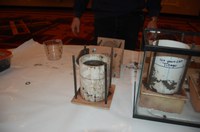NDSU Finding Ways to Improve Soil Health
(Click the image below to view a high-resolution image that can be downloaded)
When talking about health, we often think of human or animal health. However, soil health is just as important.
The North Dakota Agricultural Experiment Station and North Dakota State University Extension Service are moving forward on an initiative that focuses on alleviating soil-related problems.
“The initiative includes salinity and sodicity problems and fertility management, as well as addressing ways for landowners to manage their land resources for agricultural, recreational and wildlife needs,” says Ken Grafton, Agricultural Experiment Station director and College of Agriculture, Food Systems, and Natural Resources dean.
Soil health has been an issue for thousands of years. However, through time, those issues have changed.
“During the Dirty ’30s the risk to our soils came from drought, excess tillage and wind erosion,” says R. Jay Goos, NDSU Soil Science Department professor. “Conservation tillage and no-till systems were developed to prevent erosion and conserve water. However, we face new challenges today. One of them is salinization because of high water tables after so many wet years.”
Soil salinity is a buildup of soluble salts in the root zone of plants. With higher water tables due to more rainfall and summer evaporation of water, salts are left behind and eventually result in salt levels toxic to vegetation.
Saline and sodic soils (accumulated sodium) affect approximately 12.6 million acres of agricultural land in North Dakota.
“Soil salinity is the No. 1 issue on my list,” says Lee Briese, a crop consultant based out of Jamestown for Centrol Crop Consulting. “In the spring, there are times when the wind blows that you can see the salts blowing across the road. However, in most cases, the areas with salinity problems are small areas in a field, which makes it difficult for producers to find an economical solution.”
As part of the solution, several NDSU Extension specialists and staff have established a tile drainage research site. Tile drainage will lower the water table so water can move downward through the profile to lower the salt level at the root zone. Hans Kandel, NDSU Extension agronomist, is leading the Extension team and collaborating with Extension specialists Tom Scherer, water quality and irrigation specialist, Joel Ransom, agronomist for cereal crops, Sam Markell and Marcia McMullen, plant pathologists, and Dave Franzen, soil science specialist.
“This is a unique site because it is the only replicated research site in a multistate region comparing tiled and nontiled crops,” Kandel says. “In addition to measuring yield, plants are evaluated for disease and other growth characteristics.”
Plant pathologists are evaluating the effect of subsurface drainage on plant diseases. Soil scientists are monitoring the changes in the soil and agronomists are studying the growth, development and yield of different crops.
Other research scientists are looking at other soil health issues. Tom DeSutter, NDSU environmental soil scientist and professor in the Soil Science Department, is working on several soil health issues.
“We need to understand current and possible future soil issues so that we are ahead of issues rather than reacting to them,” DeSutter says.
Three of DeSutter’s projects are the quality of sediment after a flood, different methods of evaluating soil salinity in fields and possible byproducts that could be used as fertilizers.
There are other long-term threats to soil health.
“People are starting to talk about ‘peak phosphorus’ and ‘peak potassium’ in the same terms as ‘peak oil,’” says Goos. “The concept is that after the rate of extraction of a natural resource peaks and then declines, prices go up dramatically as competition for the remaining resource intensifies. North Dakota exports the fertility of its soil whenever a bushel of grain is hauled away. Replacing that fertility likely will be very expensive in the future. Soil fertility is a large component of soil quality. I think that soil quality issues will be with us for a long time.”
NDSU Agriculture Communication
| Source: | R.Jay Goos, (701) 231-8581, rjgoos@ndsu.edu |
|---|---|
| Source: | Lee Briese, (701) 320-3117, lee.briese@ndsu.edu |
| Source: | Tom DeSutter, (701) 231-8690, thomas.desutter@ndsu.edu |
| Source: | Hans Kandel, (701) 231-8135, hans.kandel@ndsu.edu |
| Source: | Ken Grafton, (701) 231-7655, NDSU.Exp-Dir@ndsu.edu |
| Editor: | Rich Mattern, (701) 231-6136, richard.mattern@ndsu.edu |


